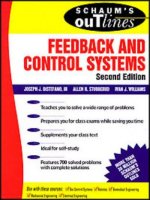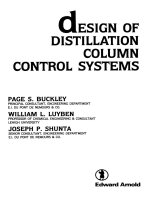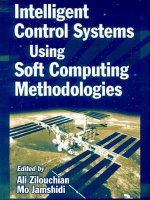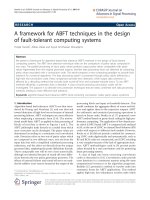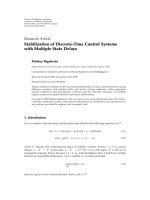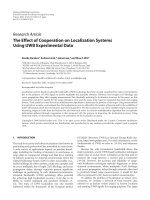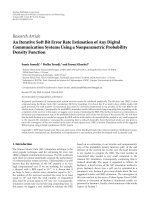Design of embedded robust control systems using MATLAB® simulink® ( TQL)
Bạn đang xem bản rút gọn của tài liệu. Xem và tải ngay bản đầy đủ của tài liệu tại đây (48.98 MB, 534 trang )
IET CONTROL, ROBOTICS AND SENSORS SERIES 113
Design of Embedded Robust
Control Systems Using
MATLAB®/Simulink®
Other volumes in this series:
Volume 8
Volume 18
Volume 20
Volume 28
Volume 33
Volume 34
Volume 35
Volume 37
Volume 39
Volume 40
Volume 41
Volume 42
Volume 44
Volume 47
Volume 49
Volume 50
Volume 51
Volume 52
Volume 53
Volume 54
Volume 55
Volume 56
Volume 57
Volume 58
Volume 59
Volume 60
Volume 61
Volume 62
Volume 63
Volume 64
Volume 65
Volume 66
Volume 67
Volume 68
Volume 69
Volume 70
Volume 71
Volume 72
Volume 73
Volume 74
Volume 75
Volume 76
Volume 77
Volume 78
Volume 80
Volume 81
Volume 83
Volume 84
Volume 86
Volume 88
Volume 89
Volume 90
Volume 91
Volume 92
Volume 93
Volume 94
Volume 95
Volume 96
Volume 99
Volume 100
Volume 102
Volume 104
Volume 105
Volume 107
Volume 108
Volume 111
Volume 112
A History of Control Engineering, 1800–1930 S. Bennett
Applied Control Theory, 2nd Edition J.R. Leigh
Design of Modern Control Systems D.J. Bell, P.A. Cook and N. Munro (Editors)
Robots and Automated Manufacture J. Billingsley (Editor)
Temperature Measurement and Control J.R. Leigh
Singular Perturbation Methodology in Control Systems D.S. Naidu
Implementation of Self-Tuning Controllers K. Warwick (Editor)
Industrial Digital Control Systems, 2nd Edition K. Warwick and D. Rees (Editors)
Continuous Time Controller Design R. Balasubramanian
Deterministic Control of Uncertain Systems A.S.I. Zinober (Editor)
Computer Control of Real-Time Processes S. Bennett and G.S. Virk (Editors)
Digital Signal Processing: Principles, devices and applications N.B. Jones and J.D. McK. Watson
(Editors)
Knowledge-Based Systems for Industrial Control J. McGhee, M.J. Grimble and A. Mowforth (Editors)
A History of Control Engineering, 1930–1956 S. Bennett
Polynomial Methods in Optimal Control and Filtering K.J. Hunt (Editor)
Programming Industrial Control Systems Using IEC 1131-3 R.W. Lewis
Advanced Robotics and Intelligent Machines J.O. Gray and D.G. Caldwell (Editors)
Adaptive Prediction and Predictive Control P.P. Kanjilal
Neural Network Applications in Control G.W. Irwin, K. Warwick and K.J. Hunt (Editors)
Control Engineering Solutions: A practical approach P. Albertos, R. Strietzel and N. Mort (Editors)
Genetic Algorithms in Engineering Systems A.M.S. Zalzala and P.J. Fleming (Editors)
Symbolic Methods in Control System Analysis and Design N. Munro (Editor)
Flight Control Systems R.W. Pratt (Editor)
Power-Plant Control and Instrumentation: The control of boilers and HRSG systems D. Lindsley
Modelling Control Systems Using IEC 61499 R. Lewis
People in Control: Human factors in control room design J. Noyes and M. Bransby (Editors)
Nonlinear Predictive Control: Theory and practice B. Kouvaritakis and M. Cannon (Editors)
Active Sound and Vibration Control M.O. Tokhi and S.M. Veres
Stepping Motors, 4th Edition P.P. Acarnley
Control Theory, 2nd Edition J.R. Leigh
Modelling and Parameter Estimation of Dynamic Systems J.R. Raol, G. Girija and J. Singh
Variable Structure Systems: From principles to implementation A. Sabanovic, L. Fridman and
S. Spurgeon (Editors)
Motion Vision: Design of compact motion sensing solution for autonomous systems J. Kolodko
and L. Vlacic
Flexible Robot Manipulators: Modelling, simulation and control M.O. Tokhi and A.K.M. Azad
(Editors)
Advances in Unmanned Marine Vehicles G. Roberts and R. Sutton (Editors)
Intelligent Control Systems Using Computational Intelligence Techniques A. Ruano (Editor)
Advances in Cognitive Systems S. Nefti and J. Gray (Editors)
Control Theory: A guided tour, 3rd Edition J.R. Leigh
Adaptive Sampling with Mobile WSN K. Sreenath, M.F. Mysorewala, D.O. Popa and F.L. Lewis
Eigenstructure Control Algorithms: Applications to aircraft/rotorcraft handling qualities design
S. Srinathkumar
Advanced Control for Constrained Processes and Systems F. Garelli, R.J. Mantz and H. De Battista
Developments in Control Theory towards Global Control L. Qiu, J. Chen, T. Iwasaki and H. Fujioka
(Editors)
Further Advances in Unmanned Marine Vehicles G.N. Roberts and R. Sutton (Editors)
Frequency-Domain Control Design for High-Performance Systems J. O’Brien
Control-Oriented Modelling and Identification: Theory and practice M. Lovera (Editor)
Optimal Adaptive Control and Differential Games by Reinforcement Learning Principles
D. Vrabie, K. Vamvoudakis and F. Lewis
Robust and Adaptive Model Predictive Control of Nonlinear Systems M. Guay, V. Adetola and
D. DeHaan
Nonlinear and Adaptive Control Systems Z. Ding
Modeling and Control of Flexible Robot Manipulators, 2nd edition M.O. Tokhi and A.K.M. Azad
Distributed Control and Filtering for Industrial Systems M. Mahmoud
Control-Based Operating System Design A. Leva et al.
Application of Dimensional Analysis in Systems Modelling and Control Design P. Balaguer
An Introduction to Fractional Control D. Valério and J. Costa
Handbook of Vehicle Suspension Control Systems H. Liu, H. Gao and P. Li
Design and Development of Multi-Lane Smart Electromechanical Actuators F.Y. Annaz
Analysis and Design of Reset Control Systems Y. Guo, L. Xie and Y. Wang
Modelling Control Systems Using IEC 61499, 2nd Edition R. Lewis and A. Zoitl
Cyber-Physical System Design with Sensor Networking Technologies S. Zeadally and N. Jabeur
(Editors)
Practical Robotics and Mechatronics: Marine, space and medical applications I. Yamamoto
Organic Sensors: Materials and applications E. Garcia-Breijo and P. Cosseddu (Editors)
Recent Trends in Sliding Mode Control L. Fridman J.P. Barbot and F. Plestan (Editors)
Control of Mechatronic Systems L. Guvenc, B.A. Guvenc, B. Demirel and M.T Emirler
Mechatronic Hands: Prosthetic and robotic design P.H. Chappell
Solved Problems in Dynamical Systems and Control D. Valério, J.T. Machado, A.M. Lopes and
A.M. Galhano
Wearable Exoskeleton Systems: Design, control and applications S. Bai, G.S. Virk and T.G. Sugar
The Inverted Pendulum in Control Theory and Robotics: From theory to new innovations
O. Boubaker and R. Iriarte (Editors)
RFID Protocol Design, Optimization, and Security for the Internet of Things Alex X. Liu,
Muhammad Shahzad, Xiulong Liu and Keqiu Li
Design of Embedded Robust
Control Systems Using
MATLAB®/Simulink®
Petko H. Petkov, Tsonyo N. Slavov and Jordan K. Kralev
The Institution of Engineering and Technology
Published by The Institution of Engineering and Technology, London, United Kingdom
The Institution of Engineering and Technology is registered as a Charity in England &
Wales (no. 211014) and Scotland (no. SC038698).
© The Institution of Engineering and Technology 2018
First published 2018
This publication is copyright under the Berne Convention and the Universal Copyright
Convention. All rights reserved. Apart from any fair dealing for the purposes of research
or private study, or criticism or review, as permitted under the Copyright, Designs and
Patents Act 1988, this publication may be reproduced, stored or transmitted, in any
form or by any means, only with the prior permission in writing of the publishers, or in
the case of reprographic reproduction in accordance with the terms of licences issued
by the Copyright Licensing Agency. Enquiries concerning reproduction outside those
terms should be sent to the publisher at the undermentioned address:
The Institution of Engineering and Technology
Michael Faraday House
Six Hills Way, Stevenage
Herts, SG1 2AY, United Kingdom
www.theiet.org
While the authors and publisher believe that the information and guidance given in this
work are correct, all parties must rely upon their own skill and judgement when making
use of them. Neither the authors nor publisher assumes any liability to anyone for any
loss or damage caused by any error or omission in the work, whether such an error or
omission is the result of negligence or any other cause. Any and all such liability
is disclaimed.
The moral rights of the authors to be identified as authors of this work have been
asserted by them in accordance with the Copyright, Designs and Patents Act 1988.
British Library Cataloguing in Publication Data
A catalogue record for this product is available from the British Library
ISBN 978-1-78561-330-2 (hardback)
ISBN 978-1-78561-331-9 (PDF)
Typeset in India by MPS Limited
Printed in the UK by CPI Group (UK) Ltd, Croydon
To our teachers and students
This page intentionally left blank
Contents
Preface
1 Embedded control systems
1.1 Introduction
1.2 Structure and elements of embedded control systems
1.2.1 Typical block diagram
1.2.2 A/D and D/A conversion
1.2.3 Sensors
1.2.4 Actuators
1.2.5 Processors
1.2.6 Software
1.3 Sampling and aliasing
1.4 Fixed-point arithmetic
1.4.1 Fixed-point numbers
1.4.2 Scaling
1.4.3 Range and precision
1.4.4 Fixed-point arithmetic operations
1.5 Floating-point arithmetic
1.5.1 Floating-point numbers
1.5.2 IEEE arithmetic
1.5.3 Floating-point arithmetic operations
1.6 Quantization effects
1.6.1 Truncation and roundoff
1.6.2 Quantization errors in A/D conversion
1.7 Design stages
1.7.1 Controller design
1.7.2 Closed-loop system simulation
1.7.3 Embedded code generation
1.8 Hardware configuration
1.8.1 Microprocessing architectures
1.8.2 Hardware description language
1.8.3 Module level development
1.8.4 System level development
1.9 Software configuration
1.9.1 Board support package
1.9.2 Application programing interface
xiii
1
1
2
2
4
5
6
7
8
10
12
12
15
18
19
22
22
23
25
25
25
28
29
32
34
36
36
37
41
44
48
54
54
56
viii
Design of embedded robust control systems using MATLAB® /Simulink®
1.9.3 Code generation
1.9.4 Code validation
1.10 Notes and references
56
60
61
2 System modeling
2.1 Plant modeling
2.2 Linearization
2.2.1 Analytic linearization
2.2.2 Symbolic linearization
2.2.3 Numeric linearization
2.3 Discretization
2.3.1 Discrete-time models
2.3.2 Discrete-time frequency responses
2.3.3 Discretization of continuous-time models
2.3.4 Discretization of time delay systems
2.3.5 Choice of the sampling period
2.3.6 Discretization of nonlinear models
2.4 Stochastic modeling
2.4.1 Stochastic linear systems
2.4.2 Discretization of stochastic models
2.4.3 Optimal estimation
2.5 Plant identification
2.5.1 Identification of black box model
2.5.2 Identification of gray-box model
2.6 Uncertainty modeling
2.6.1 Structured uncertainty models
2.6.2 Representing uncertain models by LFT
2.6.3 Deriving uncertain state-space models from
Simulink® models
2.6.4 Unstructured uncertainty models
2.6.5 Mixed uncertainty models
2.6.6 Discretization of uncertain models
2.6.7 Deriving uncertainty models by identification
2.7 Sensor modeling
2.7.1 Allan variance
2.7.2 Stochastic gyro model
2.7.3 Stochastic accelerometer model
2.7.4 Sensor data filtering
2.8 Notes and references
63
63
66
66
68
71
71
73
74
76
80
81
82
84
84
86
88
91
92
102
111
111
117
119
120
124
125
128
131
132
133
138
142
145
3 Performance requirements and design limitations
3.1 SISO closed-loop systems
3.2 Performance specifications of SISO systems
3.2.1 Time-domain specifications
3.2.2 Frequency-domain specifications
147
147
151
151
152
Contents
3.3 Trade-offs in the design of SISO systems
3.3.1 Limitations on S and T
3.3.2 Right half-plane poles and zeros
3.3.3 Limitations imposed by time delays
3.3.4 Limitations imposed by measurement noise
3.3.5 Limitations, imposed by disturbances
3.3.6 Limitations on control action
3.3.7 Limitations due to model errors
3.4 MIMO closed-loop systems
3.5 Performance specifications of MIMO systems
3.5.1 Using singular values for performance analysis
3.5.2 H∞ Norm of a system
3.5.3 Hankel norm
3.6 Trade-offs in the design of MIMO systems
3.6.1 Disturbance rejection
3.6.2 Noise suppression
3.6.3 Model errors
3.7 Uncertain systems
3.8 Robust-stability analysis
3.8.1 Unstructured uncertainty
3.8.2 Structured singular value
3.8.3 Robust-stability analysis with μ
3.9 Robust performance analysis
3.9.1 Using μ for robust performance analysis
3.9.2 Worst case gain
3.9.3 Worst case margin
3.10 Numerical issues in robustness analysis
3.11 Notes and references
4 Controller design
4.1 PID controller
4.2 LQG controller with integral action
4.2.1 Discrete-time LQG controller
4.2.2 Colored measurement noise
4.2.3 LQG controller with bias compensation
4.3 LQ regulator with H∞ filter
4.3.1 Discrete-time H∞ filter
4.3.2 H∞ Filter with bias compensation
4.4 H∞ Design
4.4.1 The H∞ design problem
4.4.2 Mixed-sensitivity H∞ control
4.4.3 Two degrees-of-freedom controllers
4.4.4 Numerical issues in H∞ design
4.5 μ Synthesis
4.5.1 The μ synthesis problem
ix
155
155
156
158
159
160
160
161
168
171
171
174
176
176
177
178
178
180
182
183
183
185
188
189
194
196
197
201
203
204
219
220
223
233
240
241
247
252
252
258
261
263
272
273
x Design of embedded robust control systems using MATLAB® /Simulink®
4.5.2 Replacing μ with its upper bound
4.5.3 DK iteration
4.5.4 Numerical issues in μ synthesis
4.6 Controller comparison
4.7 HIL simulation
4.8 Notes and references
274
276
278
287
288
294
5 Case study 1: embedded control of tank physical model
5.1 Hardware configuration of embedded control system
5.1.1 Water tank
5.1.2 ARDUINO MEGA 2560
5.1.3 Voltage divider
5.1.4 Relay block
5.2 Plant identification
5.3 LQR and LQG controllers design
5.4 H∞ Controller design
5.5 Experimental evaluation
5.6 Notes and references
299
300
301
301
303
305
305
314
319
324
333
6 Case study 2: robust control of miniature helicopter
6.1 Helicopter model
6.1.1 Nonlinear helicopter model
6.1.2 Linearized model
6.1.3 Uncertain model
6.2 μ Synthesis of attitude controller
6.2.1 Performance requirements
6.2.2 Controller design
6.2.3 Frequency responses
6.2.4 Transient responses of the linear system
6.2.5 Position controller design
6.3 Hardware-in-the-loop simulation
6.3.1 Nonlinear system simulation
6.3.2 HIL simulation setup
6.3.3 Results of HIL simulation
6.4 Notes and references
335
336
336
341
346
348
349
353
356
362
362
365
366
367
369
376
7 Case study 3: robust control of two-wheeled robot
7.1 Robot description
7.2 Closed-loop identification of robot model
7.2.1 Dynamic models from u to φ˙
7.2.2 Dynamic models from φ˙ to θ˙
7.2.3 Dynamic model of the yaw motion
377
378
380
385
389
391
Contents
7.3 Derivation of uncertain models
7.3.1 Signal-based uncertainty representation
7.3.2 Input multiplicative uncertainty representation
7.4 LQG controller design
7.5 μ Controller design
7.6 Comparison of designed controllers
7.7 Experimental evaluation
7.8 Notes and references
xi
395
395
395
399
404
407
410
416
Appendix A: Elements of matrix analysis
A.1 Vectors and matrices
A.2 Eigenvalues and eigenvectors
A.3 Singular value decomposition
A.4 Vector and matrix norms
A.4.1 Vector norms
A.4.2 Matrix norms
A.4.3 Relationships between matrix norms
A.5 Notes and references
419
419
420
421
423
423
424
426
427
Appendix B: Elements of linear system theory
B.1 Description
B.2 Stability
B.3 Controllability and observability
B.4 Lyapunov equations
B.5 Poles and zeros
B.6 Notes and references
429
429
430
430
433
435
436
Appendix C: Stochastic processes
C.1 Random variables
C.2 Stochastic processes
C.3 White noise
C.4 Gauss–Markov processes
C.5 Generation of white noise in MATLAB®
C.6 Notes and references
437
437
439
443
444
446
447
Appendix D: Identification of linear models
D.1 Identification of linear black-box model
D.1.1 Experiment design and input/output data acquisition
D.1.2 Model structure selection and parameters estimation
D.1.3 Model validation
D.2 Identification of linear gray-box model
D.3 Notes and references
449
449
450
455
468
472
472
xii
Design of embedded robust control systems using MATLAB® /Simulink®
Appendix E: Interfacing IMU with target microcontroller
E.1 Driving SPI communication
E.2 Design of Simulink® interface block
473
474
476
Appendix F: Measuring angular velocity with hall encoder
481
References
487
Index
503
Preface
The aim of the book
The aim of this book is to give the necessary knowledge about the implementation of MATLAB® and Simulink® in the development of embedded control systems.
Together, MATLAB and Simulink present a sophisticated programing environment
which may be used for the design as well as for the implementation of embedded
control systems. In this book, the authors exploit the opportunity to generate automatically and embed control code from Simulink models which allows to develop
quickly efficient and error free code. The automated code generation and the availability of powerful processors make possible the implementation of complex high-order
controllers which achieve fast and high-performance closed-loop dynamics.
The book is oriented toward the application of modern Control Theory to the
development of high-performance control laws which ensure good dynamics and
robustness of the closed-loop system to plant uncertainties. The theoretical developments are reduced to the possible minimum the accent being put on the application
issues. The basic results of Control Theory are given without proofs, and for more
information, the reader is advised to consult the notes and references given at the end
of the corresponding chapter. The presentation contains lots of nontrivial examples,
which allow to illustrate the practical implementation of theoretical results. Most of
the examples are taken from the area of motion control, but the book may also be
used by designers in other areas.
The book covers mainly the design of linear controllers which are most frequently
used in practice. This approach is justified by the principle of linearity of small
increments which states that almost any natural process is linear in small amounts
almost everywhere. Fortunately, as noted by Kostrikin and Manin [1], the small
neighborhood in which this principle is valid is sufficiently large.
An important part of the book is the freely downloadable material which contains
MATLAB and Simulink files for all examples presented in the corresponding chapters. The usage of this material can help in understanding the different issues arising
in the analysis and design of embedded control systems.
Expected audience
The book is intended as a reference source for MSc and PhD students who study
in the field of Control Engineering as well as for control engineers working in the
xiv
Design of embedded robust control systems using MATLAB® /Simulink®
industry. It can also be used as a reference for researchers in Control Engineering
who are interested in the implementation of MATLAB and Simulink in the design of
Control Systems. The first four chapters may also be used for a masters course on the
design of embedded control systems.
The contents
The book consists of seven chapters and six appendices.
Chapter 1 presents a brief overview of the embedded control systems and the
corresponding design process.
In Chapter 2, we describe several fundamental issues related to the development of
plant model, like linearization, discretization, stochastic modeling, and identification.
This chapter contains also a section on uncertainty modeling.
Chapter 3 is entirely devoted to the performance requirements and design limitations arising in embedded controller design. A significant part of this chapter are the
sections on robust stability and robust performance analysis of uncertain systems.
In Chapter 4, we present in detail the design of five basic controllers used in the
modern Control Theory: proportional-integral-derivative (PID) controllers, linearquadratic-Gaussian (LQG) controllers, and linear-quadratic (LQ) regulators with H∞
filters, H∞ , and μ controllers. For comparison purposes, all controllers are implemented on the same plant which represents the well-known cart–pendulum system.
We consider the possible difficulties in the design of these controllers and give a comparison of the properties of corresponding closed-loop systems. These properties are
illustrated by the hardware-in-the-loop (HIL) simulation of the closed-loop systems
for the worst combination of plant parameters values.
In the last three chapters, we present three case studies which describe in detail
the theoretical and practical issues arising in the design of three embedded control
systems.
In Chapter 5, we consider the design of a low-cost control system for a two-tank
plant. This chapter should be of interest to the readers who want to use low-cost
processors in the design of embedded systems.
Chapter 6 is devoted to the robust control of a miniature helicopter. We consider
the implementation of high-order controller which ensures robust performance of the
closed-loop system in the presence of severe wind disturbances.
Finally, in Chapter 7, we present the design of embedded control system of a
two-wheeled robot. In this case, we demonstrate experimentally the implementation
of 30th-order controller which ensures robust stability and performance of the closedloop system in the presence of plant uncertainty.
In Appendices A–D, we give some necessary facts from matrix analysis, linear
system theory, stochastic processes, and identification of linear models, respectively. In Appendices E and F, we discuss important practical issues like connection
between sensors and DSP and measurement of angular velocities by Hall encoders,
respectively.
Preface
xv
Acknowledgments
The authors are indebted to several people and institutions who helped them in the
preparation of the book. We are particularly grateful to The MathWorks, Inc. for
their continuous support, and to Professor Da Wei Gu from Leicester University, and
Professor Nicolai Christov from Université Lille 1 for the numerous discussions and
help. The assistance from IET editors and comments from the Reviewers are highly
appreciated. We are also very grateful to Professor Tasho Tashev, Dean of the English
Department of Engineering of the Technical University of Sofia, for his continuous
support of our work in the recent years.
Using downloadable material
As a supporting online material for this book, we present seven folders with more
than 250 .M- and .SLX-files intended for the design, analysis, and HIL simulation of
embedded control systems which may found at
/>In order to use the .M- and .SLX-files, the reader should have at his/her disposition
MATLAB and Simulink version R2016a or higher, with Control System Toolbox™
and Robust Control Toolbox™ . The programs described in Chapter 5 require the
availability of Simulink Support Package for Arduino hardware and Arduino IDE. The
programs presented in Chapters 6 and 7 require the installation of Code Composer
Studio™ release 6.0.0, Control Suite version 3.3.9 and C2000 Code Generation Tools
version 6.4.6.
Sofia, Bulgaria
December 2017
Petko Petkov
Tsonyo Slavov
Jordan Kralev
This page intentionally left blank
Chapter 1
Embedded control systems
In this chapter, we make a concise overview of embedded control systems and discuss some aspects of the corresponding hardware and software which is used in these
systems. The embedded control systems are digital systems and their performance is
affected by sampling and quantization errors. That is why, we present some basic
elements of fixed-point and floating-point computations and describe the rounding errors associated with these computations. In case of fixed-point arithmetic,
the emphasis is put on the scaling problem, which is the most important issue in
using such arithmetic. We describe briefly the stages of embedded controller design,
controller simulation, and implementation.
1.1 Introduction
According to a popular definition, every electrical or mechanical system that contains
a controller, implemented on the base of digital processor, is called embedded system.
The embedded control systems are systems in which are implemented algorithms for
real-time control using feedback. The embedded control systems represent synthesis
between modern digital technologies and control theory methods. It is necessary
to distinguish between general purpose computational devices (computers) and the
embedded system processors. The computers may execute a great number of programs
with different purpose which are used to solve computational problems. On the other
hand, the embedded system processor, which may be very powerful, performs only a
special control program. Also, the embedded system controller may contain additional
hardware which distinguishes it from the general purpose computer. Most of the
contemporary embedded systems are implemented on the basis of microcontrollers—
computational devices whose functional blocks (central processor, memory, input and
output devices, and interface buses) are combined on a single chip. From hardware
point of view, the microcontrollers represent a very-large-scale integration (VLSI)
circuits.
To work successfully in real time, the embedded system should be developed so
that the required computational cycle fits in the given time interval. For this aim, it is
necessary to choose processor with appropriate computational efficiency, to develop
2 Design of embedded robust control systems using MATLAB® /Simulink®
fast control algorithm and to create interface schemes with minimum possible delay
of signal transmission. On the second place, the embedded control system should
possess stability in respect to external data. If, for instance, the data, necessary to
obtain the result, do not arrive in time, then the system cannot produce the required
result in time. In such a case, the system should not lock, but has to continue to give
appropriate result in real time.
The process of developing embedded control systems has strongly multidisciplinary character, since it is required to perform a system integration of problems,
associated with
–
–
–
–
–
derivation of mathematical models of physical plants, sensors, communication
hardware, and so on,
development of methods for high performance control,
embedding of control algorithms in different hardware and software platforms,
carrying out communication with remote plants,
solving problems associated with power supply.
The theoretical foundation of the embedded control systems is the theory of
hybrid systems. The hybrid systems combine continuous processes described by differential or difference equations and discrete-event processes, described by finite
automata. Such systems arise in a natural way in the control of continuous processes
by the aid of digital devices and their investigation require a synthesis of control
theory and computer science. The usage of complicated robust and adaptive control
laws leads to the necessity of developing embedded system which work under the
conditions of restricted processor accuracy and relatively small sampling interval.
This represents a serious challenge both from theoretical and practical point of
view.
1.2 Structure and elements of embedded control systems
1.2.1 Typical block diagram
From control theory point of view, the embedded control system for a continuoustime plant represents a closed-loop multivariable digital control system with a block
diagram, shown in Figure 1.1. Very few plants encountered in practice are inherently
digital, so we assume that generally the plant is continuous-time. Such systems are
called sampled-data systems.
The aim of the control system is to ensure desired behavior of controlled plant
outputs in accordance with the reference signals in presence of unknown disturbances and noises in the closed loop. In the general case, the plant has m analog
control inputs produced by actuators and r analog outputs measured by the respective
sensors. The measurements are corrupted by noises which, along with the plant disturbances, may significantly affect the closed-loop system behavior. The analog sensor
Embedded control systems
References
A/D
A/D
y1(k)
yr(k)
Digital
computer
3
Disturbances
u1(k)
um(k)
D/A
with
S/H
u1(t)
D/A
with
S/H
um(t)
Controlled
outputs
Actuator
Plant
Measured
outputs
Actuator
y1(t)
yr(t)
Sensor
Sensor
Noises
Figure 1.1 Block diagram of an embedded control system
signals are sampled with sampling period Ts by an impulse sampler, which produces
digital representations y1 (k), y2 (k), . . . , yr (k) of the measured signals, where yi (k)
means the value of yi (t) for t = kTs , k = 1, 2, . . .. The sampler is a device, driven
by the system clock, that is converting a continuous-time signal into a sequence of
numbers. Normally, the sampler is combined into analog-to-digital (A/D) converter,
which also quantizes the sequence of numbers into a finite precision number. (Note
that the impulse sampler by itself does not have any physical meaning.) The digital
measurement signals are used by the controller algorithms, embedded in the digital computer, to produce the digital control signals u1 (k), u2 (k), … , um (k). These
signals are converted to the corresponding actuator inputs u1 (t), u2 (t), . . . , um (t) by
using digital-to-analog (D/A) converters. The purpose of the D/A converters is to produce analog approximations of the digital signals using appropriate reconstruction
algorithms. The analog signals u1 (t), u2 (t), . . . , um (t) are determined by hold devices
during the sample period until the next sample arrives and the process of holding
each of the samples is termed sample and hold (S/H). The analog signals ui (t) are
used as actuator inputs to control the plant behavior. The work of the A/D and D/A
converters is synchronized by the system clock with the work of the digital computer.
Note that the block diagram may contain additional elements like antialiasing filters
whose function is described in the next section. Also, it is possible that the outputs
of the analog sensors are sampled at different periods and the system may have many
controllers with different sampling periods. In the cases where the sensors have digital
outputs or/and the actuators have digital inputs, the block diagram shown in Figure 1.1
may still be valid taking into account that the A/D and D/A conversion is performed
inside the corresponding devices.
4 Design of embedded robust control systems using MATLAB® /Simulink®
w(t)
v(t)
v(t)
w(t)
S/H
Unit
impulse
t
t
Ts
Figure 1.2 Operation of the zero-order hold (ZOH)
A/D
D/A
with
S/H
Figure 1.3 Operation of the analog-to-digital converter and digital-to-analog
converter with zero-order hold
1.2.2 A/D and D/A conversion
In the simplest case, which is assumed in this book, the sample and hold process
reduces to a zero-order hold (ZOH) whose operation is illustrated in Figure 1.2. The
digital code of the signal at the sampling instant is converted into analog signal with
magnitude corresponding to the value of the digital signal and duration, equal to the
sampling period Ts . The frequency ωs = 2π/Ts is called sampling frequency. The
zero-order hold keeps constant the magnitude of the analog signal between two
sampling instants.
The operation of A/D converter and D/A converter in case of using zero-order
hold is illustrated in Figure 1.3. Commonly using a process of successive approximation, the A/D conversion (ADC) maps the analog input signal to a digital output. This
digital value is composed of a set of binary values called bits (often represented by
0s and 1s). The set of bits represents a decimal or hexadecimal number that can be
used by the microcontroller. The D/A converter transforms the digital code to signal
Embedded control systems
5
samples and then converts the binary-coded digital signal to analog signal. It is seen
that the D/A conversion with zero-order hold produces a staircase signal from the
samples sequence.
The A/D converter has two functions:
1.
2.
Sampling of the analog signal: the continuous-time signal is replaced by a
sequence of values equally spaced in the time. These values correspond to the
amplitude of the continuous-time signal at sampling instants.
Quantization: the signal amplitude is approximated by a finite precision number coded with a binary sequence. Typically, the A/D converter has 8–24 bits
resolution giving 28 –224 levels of quantization.
A drawback of the zero-order hold is that the output of the hold device is discontinuous. The discontinuities can excite poorly damped mechanical modes of the
physical process and also cause wear in the actuators of the system. That is why in
some cases, a more sophisticated hold device is used by allowing the continuous-time
signal to be a higher order polynomial between the sampling points. Using a firstorder hold the signal between the sampling points is obtained by a linear interpolation
which leads to better reconstruction of the sampled signal.
1.2.3 Sensors
Sensor is a device that when exposed to a physical phenomenon (displacement, force,
temperature, pressure, etc.) produces a proportional output signal (electrical, mechanical, magnetic, etc.). The term transducer is often used synonymously with sensors.
However, ideally, a sensor is a device that responds to a change in the physical
phenomenon. On the other hand, a transducer is a device that converts one form
of energy into another form of energy. The new generation sensors involve smart
material sensors, microsensors, and nanosensors.
Sensors can be classified as passive or active. In passive sensors, the power
required to produce the output is provided by the sensed physical phenomenon
itself (such as a thermometer), whereas the active sensors require external power
source (such as a gyroscope). Furthermore, sensors are classified as analog or digital on the basis of the type of output signal. Analog sensors produce continuous
signals that are proportional to the sensed parameter and typically require ADC
before feeding to the digital controller. Digital sensors on the other hand produce
digital outputs that can be directly interfaced with the digital controller. Often,
the digital outputs are produced by adding an A/D converter to the sensing unit.
If many sensors are required, it is more economical to choose simple analog sensors and interface them to the digital controller equipped with a multichannel A/D
converter.
6 Design of embedded robust control systems using MATLAB® /Simulink®
A number of static and dynamic factors must be considered in selecting a suitable
sensor to measure the desired physical parameter. The following list involves the
typical factors [2, Chapter 17]:
Range
Resolution
Accuracy
Precision
Sensitivity
Zero offset
Linearity
Zero drift
Response time
Bandwidth
Resonance
Operating temperature
Deadband
Signal-to-noise ratio
Difference between the maximum and minimum value
of the sensed parameter
The smallest change the sensor can differentiate
Difference between the measured value and the
true value
Ability to reproduce repeatedly with a given accuracy
Ratio of change in output to a unit change of the input
A nonzero value output for no input
Percentage of deviation from the best-fit linear
calibration curve
The departure of output from zero value over a period
of time for no input
The time lag between the input and output
Frequency at which the output magnitude drops by 3 dB
The frequency at which the output magnitude peak
occurs
The range in which the sensor performs as specified
The range of input for which there is no output
Ratio between the magnitudes of the signal and
the noise at the output
Models of sensors, appropriate for usage in embedded control system design, are
described in Section 2.7.
1.2.4 Actuators
The purpose of actuators is to control a physical device or affect the physical environment. The three commonly used actuators are solenoids, motors, and servos. Solenoids
are devices containing a movable iron core that is activated by a current flow. The
movement of this core can then control some form of hydraulic or pneumatic flow.
The next type of actuator is the electric motors. There are three main types: direct
current (DC), alternating current (AC), and stepper motors. DC motors may be controlled by a fixed DC voltage or by pulse width modulation (PWM). In a PWM signal,
such as shown in Figure 1.4, a voltage is alternately turned on and off while changing
(modulating) the width of the on-time signal, or duty cycle. AC motors are generally
cheaper than DC motors, but require variable frequency drive to control the rotational
speed. Stepper motors move by rotating a certain number of degrees in response to
an input pulse. Servos are DC motors with encapsulated electronics, built in gear and
feedback for PWM control. The servos should perform fast changes in the position,
velocity and acceleration. Most servo can rotate up to 90◦ or 180◦ , but some may
perform a full revolution. The servos cannot rotate permanently in one direction, i.e.,
they cannot be used to actuate wheels, but they are precise in positioning and are
convenient in control of mobile robots, drones, and so on.
Amplitude
Embedded control systems
50% Duty cycle
7
30% Duty cycle
t
T
T
Figure 1.4 Pulse width modulation
1.2.5 Processors
For the purpose of embedded control systems, one of the following processor
technology is frequently used.
Programmable logical controller (PLC)—The programmable logical controller
is a specialized industrial controller. PLC is a device working in a real time: the
inputs from switches and sensors are processed on the basis of a logical program
and the output controller states change to steer machine or process. PLC may work
under heavy operating conditions (dust, electrical interferences, vibration, and shock).
These controllers can be used to implement sufficiently complicated control laws.
Microcontroller unit (MCU)—In essence, this is a small computer which constitutes of processor, memory, and periphery on a single chip. The components of
most MCU are: processor, buses (address bus, data bus, and control bus), interruption controller, DMA (direct memory access) controller, ROM memory, RAM
memory, timers, inputs, and outputs. Usually, MCU have ADC, digital outputs, digital inputs, PWM outputs. Due to the comparatively low microcontroller prices, they
are widely used in mass production.
Some of the popular microcontrollers are from the PIC (programmable intelligent computer or peripheral interface controller) family. These are general purpose
microcontrollers with affordable price which have applications in robotics, servocontrollers, and so on. Other microprocessors from this family include Parallax SX
and the series Holtek HT48FxxE. Widely used are also microcontrollers from ARM
(advanced RISC machines) family, which are based on the 32-bit architecture of
RISC processors. This family keeps up the market part of about 75 percent of all
32-bit processors and almost 90 percent of all embedded processors. Examples of
ARM-processors are Intel X-Scale, the family Philips LPC2000, Atmel AT91SAM7,
ST Microelectronics STR710, and the series Freescale MCIMX27.
8 Design of embedded robust control systems using MATLAB® /Simulink®
Digital signal processor (DSP)—It is designed for specialized applications like
matrix operations, real-time filtration, sound and image processing, and so on. In
essence, the DSPs are microcontrollers (they have ROM memory, RAM memory,
serial and parallel interfaces, DMA controller, timers, controllers for interrupt processing and digital and analog periphery in some cases). For real-time control, the
32-bit controllers of Texas Instruments series C-2000: Delfino, Piccolo, InstaSPIN
and F28M3x are used. The highest speed have the microcontrollers from Delfino family, which may be used to implement complex control laws. These microcontrollers
have coprocessors, which are used to perform floating point computations.
Field programmable gate arrays (FPGA)—Integrated circuits, whose structure
usually represents a two-dimensional array of logical blocks, buses for interconnection
between them, auxiliary memory blocks and functional blocks (for instance, multipliers). The functions of these circuits are post determined by programing (electrical
configuration). FPGA can perform parallel computations (MCU and DSP cannot).
In practice, some of the fastest DSPs are built on FPGA chips. Also, there are ready
processor kernels, which are programed on FPGA chips, on which it is possible to set
very high clock frequency, i.e., their performance increases. The desired functionality
of FPGA can be configured after the device is produced, installed in a product and
even in some cases after the product is supplied to the user. This makes the FPGA a
device, which is fundamentally different from the other devices on integrated circuits.
More details about the architecture and operation of microcontrollers and FPGA
are given in Section 1.8.
1.2.6 Software
Practical implementation of control algorithm is not a trivial problem. Target hardware
platform which executes the control calculation enriches with numerous dynamical
effects the original plant. Such effects are time sampling, quantization, sample time
variation, information transport delays, real numbers formatting, and rounding. These
effects have to be accounted in plant modeling if not as controllable dynamics at
least as uncertainty. Nowadays, there are many software components with open or
closed source code, which accelerate programing process. Therefore, software design
issues are left mainly in system configuration and compatibility between software and
hardware components.
There are several ways for embedded programing. Formal languages are ubiquitous tool for programing. Expressions from such languages are derived from
certain formal grammar and have tree like structure. To accelerate further system
development, there are many visual languages too.
Ultimately, the goal of control engineer is to program the formula of his control
algorithm into the hardware platform in order to start its autonomous execution. This
goal requires securing of the following software components:
●
Periodic task execution—Usually, a hardware timer is programed to generate an
interrupt signal periodically. Then timer interrupt routine calls step function of
control algorithm to update its internal state and output according to elapsed time.


